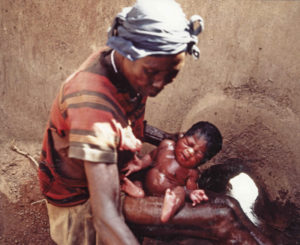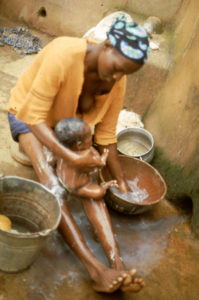Evans Akangyelewon Atuick
Management of Perceived Malaria Infections in Children among Bulsa Mothers

Introduction
The Bulsa, especially women, have a vast knowledge of local herbal and other medicinal remedies for managing various infections in infants and young children. This is because mothers are often the home healthcare givers, especially, when it concerns infections in children. In this write up, I shall focus on how mothers manage perceived malarial infections in children less than five years old.
Among the Bulsa, malaria is mostly seen as synonymous with fever, hence, fever is often a sign of malaria infection. Most people describe malaria infections by using lay taxonomies such as kazambanga [feveral/malaria infections] and duiinsa-tuem [disease of the mosquitoes]. Infections are most prevalent during the rainy season, with children more vulnerable than adults. Most of the women I spoke to did not believe that the mosquito was the sole agent for transmitting the disease; causal factors such as blood, houseflies, dirty water, unclean surroundings, wind, the hotness of the sun, too much work, eating cold food as well as the supernatural were mentioned as causes of malaria infections. These afore-mentioned perceived causes of malaria are not strange given that other studies have shown that lay perceptions of disease causation in most cases deviate from the scientific knowledge. Moreover, these responses are meaningful within the context of the worldview, culture and social environment of the Bulsa.
Against this background, I shall approach this write up by first, describing how perceived malaria is diagnosed in infants, followed by the treatment of infections.
Diagnosis of Malaria
As noted earlier, mothers are familiar with certain common systems of malaria and often self-diagnose perceived infections in children. Fever was the most common symptom of malaria known to the women I spoke to; most of them told me once a child had fever, that was a sure sign of malaria infection. One woman described how she detects malaria infection in her child in the following words:
If it [malaria] gets a child, his/her body will just become very hot and the child will start vomiting while cold will be entering him/her….
Aside fever, the following were mentioned as signs and symptoms of malaria infections in infants: body weakness, eyes changing colour (red, yellow), body shivering, skin changes in a certain way, too much sweat, loss of weight and appetite, poor sleep patterns, lack of interest in playing, prolonged sitting under the sun, yawning most of the time, stretching of body and skin rashes. The following is a quote from one of the women spoken to:
If the kazambanga [malaria] “has a child”, the body will become hot and the child will be crying and the eyes will just change colour and cold will be entering him/her. And even if the afternoon is hot like it is now, instead of sitting in the shade, you will see that, instead of playing, the child likes to sit in the hot afternoon until the body becomes okay before he or she will rise up.
Thus, most mothers appear to have fair knowledge of certain familiar signs and symptoms of malaria infections in children. It is, therefore, not surprising that a lot of them frequently self-diagnose and attempt to treat infections on their own, especially in situations where there perceived barriers to proper healthcare such as unaffordability of healthcare or long distance to health facilities.
Treatment
Bulsa mothers have good knowledge of herbal and other remedies for managing malaria infections in children. The most common herbal remedies include the leaves of certain plants such as nim (Azadirachta indica), the acacia, pawpaw, the leaves of the bean plant, kpasuiik [bad smelling plant, Ocimum canum, ‘wild basil’] and ngmanyak [bad odour type of grass that grows in valleys]. There were mothers who believed that smearing bad smelling concoctions or substances such as cow dung on the head of victims could cure them of malaria infections. One mother had this to say about how malaria is treated in children:
If you get feltiib-vaata, i.e.leaves of the nim tree and boil them and then pour the water into something like a bucket and then cover the child with a large cloth so that the heat of the water will enter the body and before long, he or she will be sweating a lot and after that, you will use the same water and bath him or her before giving him or her that same water to drink. If you do this, it will stop.
Thus, most herbal malaria remedies are usually prepared in the form of liquid concoctions through boiling or squishing of the leaves of known medicinal plants found in the area. These are administered through a combination of exposure to heat from the concoction, bathing with the water from boiled herbs and then, getting the victim to drink some of the concoction. However, some remedies such as the cow dung and other smelling things are usually smeared on the bodies of suspected victims for healing. Mothers spoken to told me they would still resort to healthcare from the biomedical facility if there were no visible signs of recovery after the application of the herbal remedies.
Conclusion
This study shows that rural Bulsa home healthcare givers, especially mothers, appear to have considerable knowledge of certain familiar signs and symptoms of malaria and use these to self-diagnose and treat suspected cases in their children. The use of local herbal and others remedies in managing infections are time-tested learned behaviours that are usually acquired from older generations or knowledgeable age cohorts. However, there are obvious dangers in self-diagnosing and treating perceived malaria in children at home; symptoms of malaria are similar to those of other infections, hence, mothers could be treating the wrong infection, while undue delay in seeking prompt healthcare could lead to complicated malaria and/or other conditions that could result in death. Intensive public education is therefore needed to educate mothers on the need to seek prompt and proper healthcare when suspected cases are noticed in children.

- Contents of BULUK 12
- Editorial
- Events
- Who on Earth is interested in the Bulsa?
- Discussions in the Facebook Group “BULUK KANIAK”
- New Published and Unpublished Studies on Bulsa Culture
- The Sights, Sounds and Glitter of Feok 2018
- Report on BHCS Exhibition of Bulsa Material Objects at Feok 2018 in Sandema
- Bulsa Pomp and Pageantry
- John A. Agandin: Two Poems
- The Medical System of the Bulsa
- List of Plants for Medicine and Other Purposes
- Dental Health – the next lifestyle disease?
- Free surgical procedures by Dr. Benjamin Akinkang’s Team of Hope
- Ambulance not on the Road: A Disgrace to Health Care for Buluk
- Management of Perceived Malaria Infections in Children among Bulsa Mothers